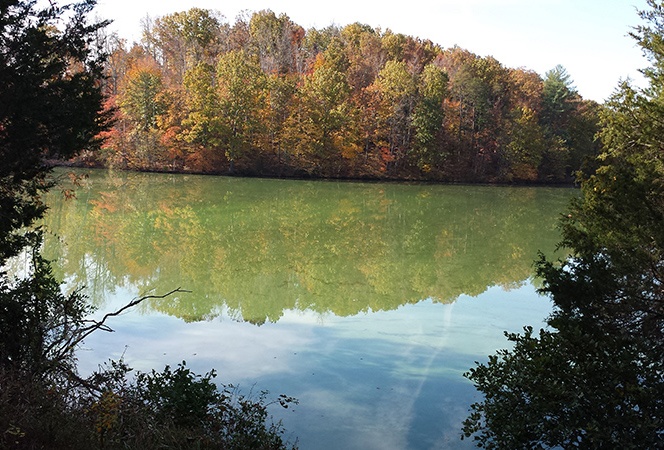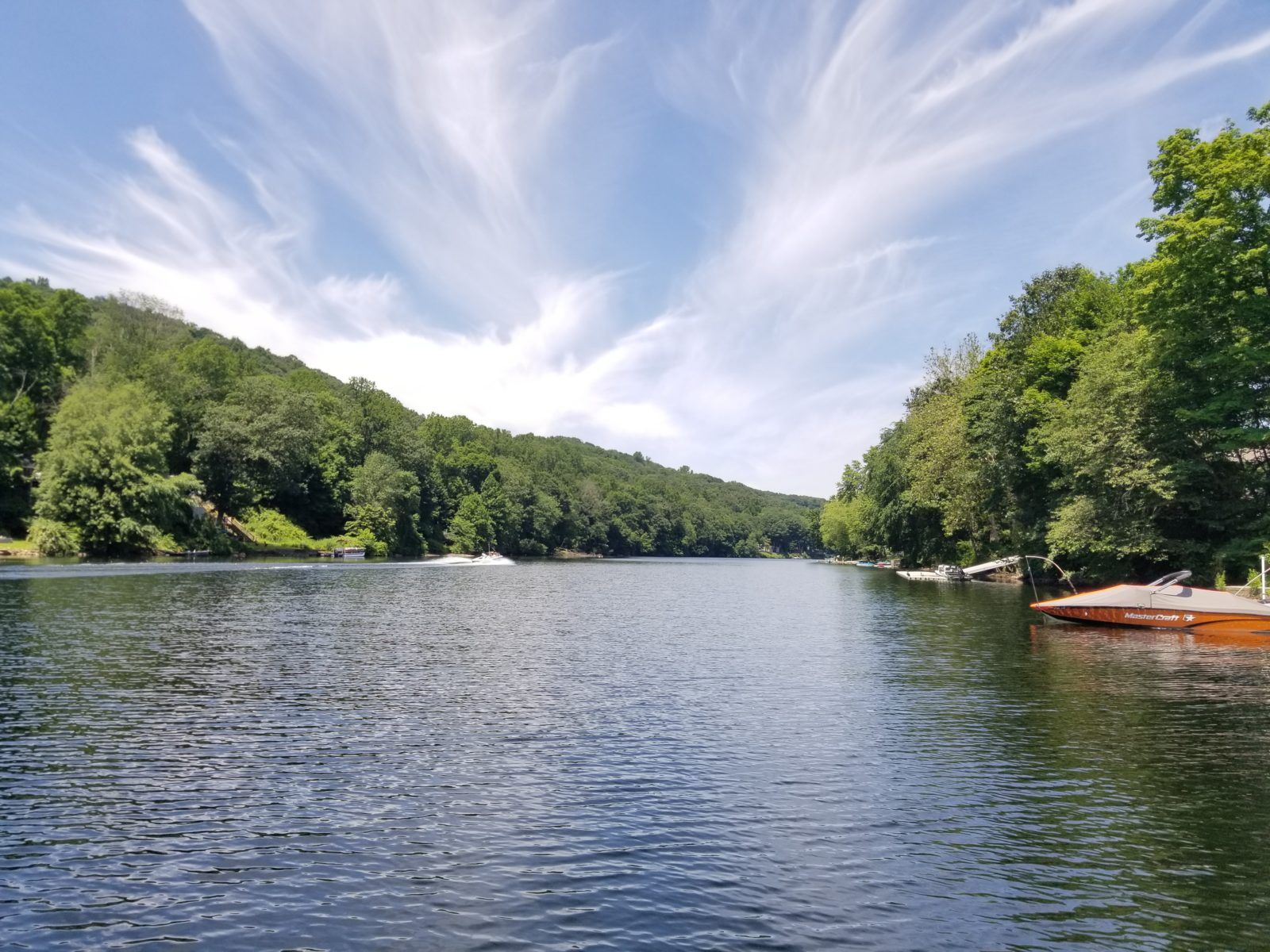Understanding Chronic Blue-Green Algae Issues
March 11th, 2016
AS SEEN IN Pond Boss Magazine, January/February 2016: Written by Industry Expert, David Beasley, Fisheries Biologist and Director of Fisheries
 Maybe you’ve seen it, maybe not. That neighboring pond down the road used to be a beautiful, blue color. When it rained it turned muddy, but after a few days, or a week, it settled sparkling clear, shimmering in sunshine. Now, a few years later, late summer, it looks like someone spilled turquoise paint on the surface. It has a musty odor—you can even smell it from the road.
Maybe you’ve seen it, maybe not. That neighboring pond down the road used to be a beautiful, blue color. When it rained it turned muddy, but after a few days, or a week, it settled sparkling clear, shimmering in sunshine. Now, a few years later, late summer, it looks like someone spilled turquoise paint on the surface. It has a musty odor—you can even smell it from the road.
What happened?
Ponds and lakes with chronic blue-green algae issues can be found across our beautiful country. Each algae-prone waterbody is slightly unique, but many are plagued by similar underlying issues. Failure to take proper proactive steps and lack of a preventative maintenance plan are often big reasons waterbodies become plagued with algae issues sooner than they should.
Chronic blue-green algae issues typically stem from eutrophication, the natural aging process where a waterbody’s nutrient load increases over time. This increase in nutrients, which is also known as an increase in productivity, is influenced significantly by phosphorus. Some examples of how phosphorus enters waterbodies would be organic matter such as leaf litter from trees, lawn and garden fertilizers, livestock waste, faulty septic systems, and erosion.
Although nitrogen is a culprit capable of fueling intense pond algae growth, it is less of a concern than phosphorus when considering long-term consequences. Nitrogen naturally breaks down through the process of denitrification, being expelled into the atmosphere as nitrogen gas. Phosphorus, on the other hand, does not breakdown naturally and exit the system. As a result, phosphorus accumulates in the sediment layer on bottom. Accumulation of phosphorus is natural, but unfortunately can hit a tipping point where the load starts fueling significant amounts of aquatic plant and algae growth. Once that point is reached, the pond or lake is much more vulnerable to intense blue-green algae blooms.
Another difference between nitrogen and phosphorus is nitrogen-rich waterbodies promote production of green algae species. Green algae are favorable to aquatic communities and work their way up the food chain. Waterbodies prone to green algae issues, fueled by nitrogen, are typically in a better position to implement effective management strategies and overcome their algae woes.
This is not necessarily the case for phosphorus-rich water, which favors production of blue-green algae. In addition to producing toxins, blue-green algae are much less beneficial to the aquatic community since many species do not move up the food chain.
 When ratios of nitrogen and phosphorus become unbalanced, blue-green algae can become dominant. As eutrophication occurs, phosphorus continually accumulates in a pond’s mucky sediment layer. As phosphorus accumulates, chances are greater that key nutrient will elevate levels that fuel algae growth. Although muck sequesters some, accumulated phosphorus has a cumulative effect. As a result, there comes a point where either the nutrients need to be remediated by removing the mucky layer of sediment and organic material, or they need to be accepted and reallocated the best way possible. Both options have negative drawbacks. In some cases it can be less expensive to build a new waterbody rather than removing the nutrient rich muck with heavy equipment. There is no way around it, remediating high phosphorus levels is typically very expensive.
When ratios of nitrogen and phosphorus become unbalanced, blue-green algae can become dominant. As eutrophication occurs, phosphorus continually accumulates in a pond’s mucky sediment layer. As phosphorus accumulates, chances are greater that key nutrient will elevate levels that fuel algae growth. Although muck sequesters some, accumulated phosphorus has a cumulative effect. As a result, there comes a point where either the nutrients need to be remediated by removing the mucky layer of sediment and organic material, or they need to be accepted and reallocated the best way possible. Both options have negative drawbacks. In some cases it can be less expensive to build a new waterbody rather than removing the nutrient rich muck with heavy equipment. There is no way around it, remediating high phosphorus levels is typically very expensive.
For pond owners, slowing the eutrophication process should be a primary goal. Ideally, this thought process should be incorporated during construction planning. Wooded watersheds contribute nutrients at a gradual rate. Other areas such as agricultural or urbanized areas add nutrients at a significantly faster rate.
Preserving a natural watershed helps. Additionally, digging deeper, building forebays at each primary inflow area, and minimizing erosion helps deter eutrophication. This is especially helpful in urban and farm areas.
For those who did not have the privilege of putting this foresight into construction, develop a pond management strategy now to deal with it efficiently. The best starting place? Analyze water quality. Sure, you already know about pH, alkalinity, and hardness. Now is the time to understand phosphorus and nitrogen. Many different parameters influence water. Secondly, have sediment samples analyzed. It is important to collect the best information and then have it objectively interpreted by an expert, such as a biologist. Ask your biologist how this data interacts to potentially cause algae. Consider collecting dissolved oxygen and temperature profiles from the deepest area of the waterbody, too. This data will provide insight towards the condition of your water and what solutions should be considered. For chronic blue-green algae issues, it is critical to understand algae isn’t the problem. It’s a symptom of nutrient load. Addressing algae means altering water chemistry to a more favorable state. Altering water chemistry is a long term solution, but does not necessarily address immediate needs of a bad bloom.
When algae densities exceed acceptable thresholds, it may be best to treat with algaecides to suppress algae growth. Treatments will likely be short-lived. Many species of blue-green algae are rapid growers, and if conditions are prime for growth, they can increase biomass at exponential rates. This capability may result in the suppression of algae for a couple of weeks after an algaecide treatment. Some enhanced algaecides are formulated to remove available phosphorus from the water column.
Although some waterbodies experience chronic blue-green algae issues year round, many only experience them during summer and fall months. The reason for this is related to water chemistry and availability of free, reactive (i.e. available) phosphorus. During summer months, most phosphorus-rich waterbodies become anoxic below their thermocline. These anoxic conditions promote anaerobic bacteria activity, which releases free reactive phosphorus from the sediment. As available phosphorus in the water column increases over the course of the growing season, water chemistry starts to favor blue-green algae. Once this occurs, prepare to deal with blue-green algae issues for the remainder of the growing season. Best strategies will depend on site conditions, water quality, the waterbody’s history, goals, and budget.
One great tool is a properly sized aeration system. With proper aeration, a waterbody can maintain sufficient oxygen levels throughout the water column, minimizing release of available phosphorus from the sediment layer. Although this may not reduce the amount of total phosphorus in the sediment, it does help keep it bound in its unavailable form.
Another feasible solution, in many cases, is promotion of desirable aquatic vegetation. This process of promoting growth of healthy, native aquatic plants is difficult for some to accept since people tend to prefer minimal aquatic growth. Allowing growth of aquatic plants helps redirect phosphorus and reduce availability of nutrients that fuel algae production. While this does not slow down eutrophication, it does make the situation more tolerable and safer since it helps discourage the toxic-producing blue-green algae. For some, this idea of establishing aquatic plants sounds great. Unfortunately, many people with chronic algae issues have an established population of grass carp. Grass carp in an algae-rich waterbody are typically hungry since there is minimal aquatic growth for them to eat. It’s hard to establish aquatic plants in front of big, hungry grass carp.
 Another option to address heavy phosphorus loads is to mitigate free reactive phosphorus by applying aluminum sulfate or a product called Phoslock. Binding available phosphorus is a fairly popular approach and can be included as part of an integrated method to resetting the water chemistry to a pre-tipping point level. In some cases Phoslockhas been used to form a barrier, capping the sediment layer and sequestering the heavy phosphorus levels below.
Another option to address heavy phosphorus loads is to mitigate free reactive phosphorus by applying aluminum sulfate or a product called Phoslock. Binding available phosphorus is a fairly popular approach and can be included as part of an integrated method to resetting the water chemistry to a pre-tipping point level. In some cases Phoslockhas been used to form a barrier, capping the sediment layer and sequestering the heavy phosphorus levels below.
For some, the option to dredge the waterbody is feasible. If so, this is likely the most successful approach to removing phosphorus from the system. Unfortunately, dredging waterbodies can be incredibly expensive, depending on the site and local regulations.
Okay, so what is the best advice? Prevent excess nutrient loading with vegetative buffers, better watershed management practices, forebays, and by fixing eroded areas. Manage your water chemistry via aeration and allowing healthy amounts of aquatic plants. If you have immediate issues with blue-green algae, herbicides are like mowing the yard. Plan on more than one treatment until you figure out how to re-appropriate those troublesome nutrient loads. Look at binding phosphorus with products mentioned above, but know that you will be sequestering phosphorus into the bottom sediment. Be sure to understand you’ll need to think about nutrient loading long-term, not just a one-and-done management strategy.
If you do the preventative things, mitigate current issues to keep your water immediately healthy, and have a strategy to relieve your pond of excess nutrients, you’ll put off nature’s aging process.
At the end of the day, chronic blue-green algae issues can be a significant challenge, so don’t procrastinate. The key to success is to recognize this is a long-term battle, and you need to establish a management plan that fits your situation and budget. If this seems intimidating, locate and work closely with someone who understands the complex relationship between all of the environmental variables that are contributing to your situation.
Contact the experts at 888-480-5253 for all of your lake, pond and fisheries management needs.
David Beasley is a Fisheries Biologist and the Director of Fisheries for SOLitude Lake Management. SOLitude Lake Management has been committed to providing full service lake and pond management services that improve water quality, preserve natural resources, and reduce our environmental footprint. Lake, pond and fisheries management services, consulting, and aquatic products are available nationwide. Learn more about SOLitude Lake Management and purchase products at www.solitudelakemanagement.com










